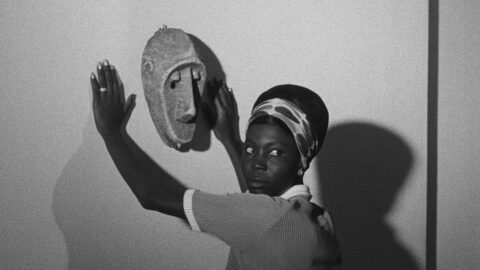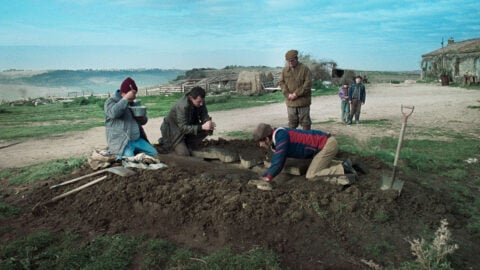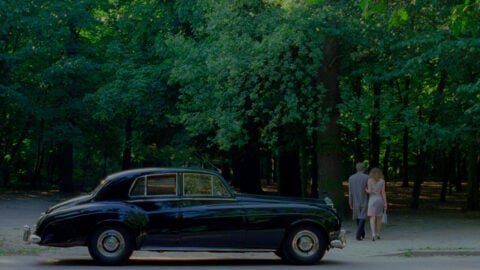Bombast: Horror Business

The Quatermass Experiment
Halloween, which traces its roots back to the Gaelic festival of Samhain, is preceded by the one week in the year when all natural order is inverted, and decent, upright film pubs and sites pretend to care even a little bit about horror movies. It’s a grudging concession. As much as we may try to domesticate horror, it remains a touchy, indigestible subject—is there any other genre for which the discourse that surrounds it involves a punctilious avoidance of discussing the thing itself? Horror-as-metaphor is a much-beloved detour, while comedian Paul F. Tompkins has made hay with the “I think we all like to be scared” cliché (Track 4 on the 2009 album Freak Wharf, if you’re interested). The basic appeal, of course, is primitive, ritual. It is a propitiatory offering, allowing others to die in our place. The poet Hart Crane gets to the meat of the matter:
“It’s no use to tell you how futile I feel most of the time—no matter what I do or conceive doing, even. Part of the disease of the modern consciousness, I suppose. There is no standard of values in the modern world—it’s mostly slop, priggishness and sentimentality. One had much better be a wild man in Borneo and at least have a clear and unabashed love for the sight of blood.”
This is from a letter that Crane posted in 1927, some five years before he hopped from the deck of the steamship Orizaba into the Gulf of Mexico, and 84 years before James Franco, beginning a rifling through the costume trunk of American literature that continues to this day, would portray Crane in his New York University MFA film The Broken Tower.
At the same time that Crane was pining for a return to savagery, another sickly giant of American letters, Howard Phillips Lovecraft, was hunched over a desk at 10 Barnes Street in Providence, Rhode Island, writing story after story that evinced a fascinated revulsion with that same subject: man’s devolution to the level of beast. Lovecraft’s yarn “The Horror at Red Hook” appeared in the January 1927 issue of Weird Tales. He’d written it a year and a half earlier, during his brief, miserable sojourn in Brooklyn with his then-wife, Sonia Greene. It deals, as do many of Lovecraft’s tales, with an ongoing, shadowy conspiracy to invite a vanquished race of slumberous Old Gods back to our terrestrial plane. In this case the conspiracy was being carried out in the Red Hook section of Brooklyn, described as “a maze of hybrid squalor near the ancient waterfront” where were carried out “antique witcheries and grotesque marvels discernible to sensitive eyes amidst the poison cauldron where all the varied dregs of unwholesome ages mix the venom and perpetuate their obscene terrors.” You get the idea.

In the Mouth of Madness
Lovecraft labored to make a living by writing for the pulps, but he couldn’t have done much worse for himself financially if he’d been a strict Axel’s Castle modernist like Crane. Today, however, his acolytes are legion, and his influence on fantasy-horror can’t be measured in terms of adaptations alone. I’ve written in the past about the important relationship between Lovecraft’s work and that of John Carpenter, particularly as evidenced in Carpenter’s 1994 In the Mouth of Madness. What Carpenter identifies as Lovecraft’s particular preoccupation—the existence of “the hidden world, the world underneath”—is visible in that film, as in a great many of Carpenter’s, even those which aren’t precisely thought of as “his.” Last week I re-watched Halloween III: Season of the Witch (82), the third of 10 sequels and re-makes to follow in the wake of Carpenter’s 1978 breakthrough Halloween, and the only film in the franchise which doesn’t feature the implacable killing machine Michael Myers. It was the last Halloween film made with the direct involvement of Carpenter and Debra Hill, who’d co-written the first, and who are credited as producers here. They also brought on board Nigel Kneale, the English science-fiction writer best known for the Quatermass films—Carpenter would adopt the nom-de-plume “Martin Quatermass” on his 1987 Prince of Darkness in his honor—to contribute to the original script, though Kneale would request his name removed from the final film.
The screenplay would eventually be credited to Tommy Lee Wallace, also the film’s director—he had played in a band called The Kaleidoscope with Carpenter when they were high-school kids in Bowling Green, Kentucky, followed Carpenter to film school at the University of Southern California, and had a hand in all of his buddy’s early successes in one capacity or another. Carpenter also contributed to the Halloween III script, and there is much in the film—the imputation of collusion between sinister, atavistic forces and corporate interests in contemporary America, the idea of mass media being used as a vehicle to carry harmful subliminal messages—that will reappear six years later in his They Live (which is, it should be mentioned, a far more effective film).
The corporate villain in Halloween III is Silver Shamrock Novelties—Carpenter recorded their insidiously catchy to-the-tune-of-“London Bridge” jingle, which appears in commercials popping up on television screens throughout the film, as well as the rest of the score, with Alan Howarth. Silver Shamrock owns the city of Santa Mira lock, stock, and barrel—it’s a classic California company town, though the omnipresent surveillance cameras are a new touch, two years ahead of 1984. (The film was shot in Loleta, located in the far northeast of the state in Humboldt County.) Dr. Daniel Challis (Tom Atkins) and Ellie Grimbridge (Stacey Nelkin) come to Santa Mira to investigate the death of Ellie’s father, a five-and-dime store proprietor who was murdered after a trip to pick up a shipment of Silver Shamrock masks. Once there, they discover that Silver Shamrock CEO Conal Cochran (Dan O’Herlihy)—of Celtic stock, like most of the town’s population—is in fact a pagan sorcerer; that Ellie’s father was killed for knowing too much by one of the army of lifelike automatons which Cochran has built to do his bidding; and that, by broadcasting a subliminal signal across all network airwaves on All Hallow’s Eve, Cochran will activate a microchip containing a piece of a filched Stonehenge rock built into Silver Shamrock masks, killing the wearer and unleashing a pestilence of untold proportions.
Of all the movie’s contrivances, the fact that every child in America has a burning desire to purchase one of the rather lame Silver Shamrock masks is perhaps the hardest to swallow. Maybe they’re so popular because there isn’t any competition? The blockbuster has long profited through this model. Indeed, Halloween III is full of passing references to corporate consolidation. “Business was getting bad,” Ellie tells Dr. Challis of her father’s store, before asking “I suppose you shopped at the new mall like everybody else.” Later, posing as a buyer, Ellie chats with another woman in town to visit the factory, who complains that “Ever since they started doing big volume business the little guy has to stand in line.” Cochran’s automatons, like the yuppies of They Live, are camouflaged in the three-piece costumes of respectability. (“He looked like a businessman,” is how Dr. Challis describes Ellie’s father’s assassin.) With Halloween III and They Live, it’s tempting to say that Carpenter substituted Lovecraft’s Cthulu Mythos with his own “progressive,” anti-corporate version of same, though this oversimplification fundamentally misunderstands the antiquarian Lovecraft, whose xenophobia went hand in hand with his detestation of the industrialization that had brought mongrel hordes to his New England and who, by the end of his life at least, can be found self-identifying as a New Deal Democrat.

Halloween III: Season of the Witch
Season of the Witch is available on Blu-ray as part of Halloween: The Complete Collection, released in September by Shout! Factory. Those in the greater New York area may also see the film projected on 35mm tonight at the Alamo Drafthouse in Yonkers, which showed A Nightmare on Elm Street 2 this past Tuesday. All of this is part of the harvest of big-screen horror that occurs annually at this time of year, which includes the eighth edition of the Film Society of Lincoln Center’s “Scary Movies” and Anthology Film Archives’ 12-hour “Day of the Dead” horror marathon/crapshoot.
Given that Halloween III deals with the mass manufacture and sale of sinister objects with eldritch import, it might seem like a shoo-in for inclusion in another seasonally appropriate program at AFA which is ending its weeklong run tonight, titled “Industrial Terror.” In fact, the focus of “Industrial Terror” is the relationship between two regional filmmaking phenomena which flourished away from the coastal capitals of American film culture: exploitation filmmaking, particularly horror; and the so-called “industrial film,” a category which encompasses classroom films, corporate-sponsored films, training films, government films, and so on.
The series pairs an industrial film with a genre film by the same director, six pairings in all. For example: Larry Yust and his trusty DP Isidore Mankofsky bring the same level of cinematographic polish and dab-handed editing to their adaptation of Shirley Jackson’s The Lottery (69) for Encyclopedia Britannica Films as they do to their sui generis 1974 feature Homebodies, in which the residents of a Cincinnati tenement, facing displacement by urban redevelopment, turn to industrial sabotage and outright murder. The Lottery and Homebodies both assume a savagery lurking just below the surface of American life, and they share the sense of gallows humor also found in Yust’s Live or Die (79) for the E.C. Brown Foundation, in which the autopsy of two middle-aged bodies is intercut with scenes from the lives of the deceased, elucidating the choices which ended them early.
The series makes the most of such thematic linkages, as in the matching of Herschell Gordon Lewis’s Carving Magic (59) and Blood Feast (63)—also paired on Something Weird’s 2000 DVD release—both of which share a leading man (William “Rooney” Kerwin) and an abiding interest (sawing through flesh). In the case of Breakthrough (53) and The Satanist (68), we have two films that are concerned with laying pipe, though in two different senses of the word. The first, credited to one Spencer Crilly, is an industrial made for the Ingersoll-Rand company, whose stock-in-trade is pneumatic drills; it documents the digging of the 10-mile Kemano Tunnel in British Columbia, built to divert the flow of the Nechako River to a hydroelectric dam in Alcan. The second, directed by someone with the no-more-likely-sounding moniker Zoltan G. Spencer who is apparently one and the same individual, concerns a writer and his wife who, while on an extended holiday to relieve his nervous tension, discover themselves to be living down the road from a pagan sex cult.1

The Satanist
A black-and-white sexploitation romp, The Satanist begins, as does many a Lovecraft tale, with the introduction of a narrator who has returned to the safety of the known world after being driven to the very brink of insanity through contact with “the hidden world, the world underneath,” and who promises to relay his mind-bending experience to us, the audience. This one narrates practically everything we see, in fact, as there is no synch sound, though there is musical accompaniment from a pan-handed, possibly stoned go-go bar pit band, using what sounds like a cookie sheet for percussion. Narrator and wife routinely peep on their occultist neighbor’s sex rituals—because it’s 1968, one still needed to go to the Danes, the Swedes, or to a Michelangelo Antonioni film to glimpse a mons pubis, so there are tits and ass on display but nothing more, and the fellas decorously keep their saggy white underpants on during the act of physical love, as befits a gentleman. Eventually, these dirty birds will be swept into a bacchanal involving men and women wearing domino masks and ponchos, where he will be chained to the wall and subjected to an elaborate cuck fantasy, watching a succession of men wearing a ram’s head mask more suitable to a high school mascot than a Black Mass have their way with his wife.
In every filmmaker the businessman and the artist co-exist, though in radically varying ratios and amounts. I can’t speak for Zoltan G. Spencer/Spencer Crilly’s business acumen without going through his books, nor have I thoroughly combed through his filmography, but The Satanist seems to me the work of an only-just-competent wiggle salesman. H.G. Lewis was trained in sales, and later distinguished himself as author of such volumes as How to Write Powerful Catalogue Copy and Hot Appeals or Burnt Offerings; to this day he insists that he only made gore films with the purpose of turning a buck on the grindhouse circuit, though the gleefully obscene imagination of the movies that he did make belies that claim, and Lewis sometimes achieves effects that are disconcertingly near to the artistry of contemporary Underground filmmaking. As for Yust, I’ve had the pleasure of meeting the man: he has the bearing of a born autocrat; the handful of films that he did manage to make are the work of a real artist; but for one reason or another they weren’t enough to sustain a feature filmmaking career.
For a period of some 20 years it was George A. Romero who, in the American horror industry, seemed to offer the greatest promise of balancing business and artistry. While independently producing a streak of films at once absorbingly visceral and charged with radical content, he did a pays-the-rent side-business in sports profile TV documentaries and commercials with his producer and eventual partner in Laurel Films, Richard P. Rubinstein. Romero was represented at “Industrial Terror” by the film that started it all, 1968’s Night of the Living Dead, preceded by a reel of the commercials that he shot for his Latent Image company between 1962 (a year after the Bronx native graduated from Pittsburgh’s Carnegie Mellon University) and 1973.
Much as I admire Night, the link between Pennsylvania industry and terror is most apparent in Romero’s Martin (77), which revolves around one of the Eastern European communities of the so-called “Rust Belt” who immigrated to America for work when the factories were still booming, bringing with them their native folklore and superstition—the same polyglot masses that Lovecraft despised. Martin was shot in Braddock, Pennsylvania, a city whose name has in recent years become synonymous with “postindustrial decay,” and which happens to be the subject of a series that “Industrial Terror” dovetails with on the AFA calendar, combining the theatrical premiere of the French-produced documentary Braddock America with two works by homegrown filmmaker Tony “Bard of Braddock” Buba. (He recorded sound on both Martin and Romero’s 1978 Dawn of the Dead.) This juxtaposition of programs seems appropriate, as the 21st century has brought on a cross-pollination of horror and documentary, with found-footage horror adopting the aesthetic of cinema verité, curiously at much the same time that it has abandoned horror’s former offhand social concern. (I urge readers to compare the wholly depoliticized scenes in the Newark projects in World War Z to the slum-clearing shakedown in Romero’s Dawn of the Dead.)

Homebodies
Writing about Gasland in a year-end roundup of 2010 releases for n+1, A.S. Hamrah noted that “Documentaries now do what both TV news and horror movies used to do—break real stories and scare the shit out of you.”2 In the regionally grounded horror film, shoe-leather local reportage was broadcast nationally. Last October, Cinefamily’s “The United States of Horror” series highlighted shot-on-location films that give starring roles to little-screened corners of this nation and their attendant local mythology. Among them were a number of the “Industrial Horror” selections (Homebodies, William Girdler’s 1974 Louisville-shot Abby, Herk Harvey’s 1962 Lawrence, Kansas chiller Carnival of Souls), as well as Romero’s Martin and products by one-man local industries like Arkansas’s Charles B. Pierce (The Town That Dreaded Sundown, 76) and Texas’s Tobe Hooper (Eaten Alive, 77). Now, the audience of the American horror movie may never have been exclusively blue-collar, nor was the industrial film ever exclusively tied to industry. Without getting into causal relations, however, we can safely say that a robust American working class coincided with a robust business for independent—as opposed to corporate—horror.3
Today we’re reassured that America is gaining new manufacturing jobs, though very few of these would fund such luxuries as a babysitter and tickets to the multiplex, and the world visible in the films that I’ve discussed is now as remote as the audiences that they originally serviced. Over-the-Rhine, the Cincinnati neighborhood where Yust shot Homebodies, has been gentrified at one of the fastest rates in the country. By now Halloween III’s Silver Shamrock Novelties probably would’ve ditched Santa Mira and headed back to Ireland to lower their tax rates. (Ingersoll-Rand, who cut Spencer Crilly/Zoltan G. Spencer a check to shoot Breakthrough back in 1953, did exactly that in 2009, after seven years in Bermuda.) As for the super-wealthy—I’ll refer you to the E.G. Marshall episode in Romero’s Creepshow for wishful thinking.
The success of the regional horror film, which produced glories enough in its own right to more than justify its existence, also helped to envision a decentralized apparatus for independent filmmaking in America. The movie I’ve seen this year that best captures the “United States of Horror” spirit is a certifiable indie outlier: Buzzard, writer/director/star Joel Potrykus’s follow-up to 2012’s Ape. Like William Dear, whose Northville Cemetery Massacre (76) also played “Industrial Terror,” Potrykus is based in Michigan. His movie, which has stuck with me more than I would’ve ever expected after one a-few-notches-above-amusement viewing in the spring, concerns Marty Jackitansky (Joshua Burge), a metalhead rip-off artist who squeezes everything he can from his autopilot white-collar job, and who spends his free time playing video games with a doofus work buddy (Potrykus) and forging a “power glove” which imitates the razor-fingered mitt of Freddy Krueger.
Lurking in the boiler room of Springwood, Ohio’s collective unconscious, Krueger was an industrial nightmare troubling the suburban reverie—a bit of foreshadowing, this, for when one of Jackitansky’s schemes threatens to backfire, he’ll run for cover to the gutted city of Detroit, a Braddock on a massive scale. As Marty’s material situation devolves, a wound on his palm which he’d amateurishly treated begins to go through various stages of putrescence—a nagging return of the physical and reminder of his own basic incompetence which accompanies his return to the carrion-like remains of the urban-industrial world. While not precisely beholden to genre dictates, Buzzard picks up a strain which runs through American horror as imagined by Lovecraft, Carpenter, Romero, and Yust’s Homebodies: it’s the economy, stupid.
1. The print of The Satanist played at Anthology was only recently discovered (or disinterred) by Harry Guerro of Philadelphia’s Exhumed Films. (Its only previous trip through a projector this century occurred this past summer, at Exhumed’s “Forgotten Film Festival.”) It was “Industrial Terror” curator Jon Dieringer who discovered that Spencer had also worked under the pseudonym Crilly—or was it Crilly working under the pseudonym Spencer?—and, through a reference in a 1955 issue of the trade journal Compressed Air Magazine, traced the director of The Satanist back to the rugged mountains of B.C. Per IMDb, The Satanist was released exactly nine days after Rosemary’s Baby—though the Ira Levin novel on which Roman Polanski’s film was based had already infiltrated the public consciousness, and summoning-as-plot-hook was hardly something new. In Blood Feast, to take only one instance, Fuad Ramses (emphatically played by Mal Arnold) is butchering Miami’s bachelorettes to give their mangled corpses to the goddess Ishtar, represented by a gold spray-painted department store mannequin.
2. In fact, I’ve never been convinced that scaring the shit out of people is or should be the principal aim of a horror movie. Here is Parker Tyler, in his 1947 Magic and Myth of the Movies:
“The mistake made by disgusted reviewers is to assume that the object of supernatural horror in films is to frighten, in any serious sense of that infinitive… Nobody goes to the theater to be frightened. Most, including children, go to be thrilled. The esthetic thrill of fear, of mock fear, is pleasure. It may be conventional to have contempt for those adults childish enough to shudder with pleasure at the sight of a lovely, seminude woman helpless in the arms of an irresponsible and repulsive synthetic man. But the obscure processes of sadism are certainly not contemporary news. Admittedly contempt for this sort of thing is the critical device not only of taste but also of an age of reason and materialism; critics may think it merely the maintenance of a high intellectual tone to sniff at low-grade popularizing of emotion, adjudging the popular pleasure in screen monsters as moronic. But the naively susceptible in movie-house audiences are actually more sophisticated than the critics…”
3. The brief J-horror invasion of the early Aughts may, in this light, be compared to the Eighties panic over the domestic market penetration by Panasonic, Sony, Honda, Toyota, and other Japanese companies. These technophobic tracts—a friend used to call them “I’m afraid of my cell phone!” movies—suited a white-collar nation that has largely shifted from goods to services, from the physical to the virtual.







